
|
MAIN MENU |
ABOUT CAMBODIA |
RECOMMENDATION |
PHOTO GALLERY |
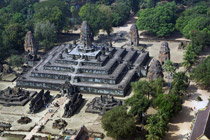
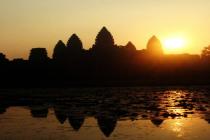
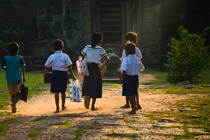
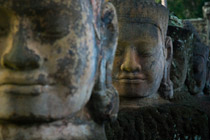
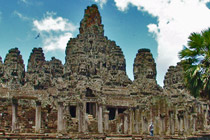
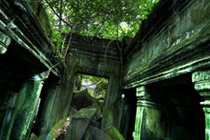



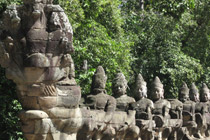
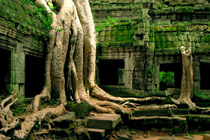

|
SIGHTSEEING AND ACTIVITIES
As enthralling as the temples of Angkor may be, there are lots of other things to see and do around Siem Reap. Seeing a bit of Cambodia away from the temples can help avert ‘temple-burnout’ and round out your Cambodian experience as well as help Cambodia by taking some tourist pressure off of the temples and spreading the tourism dollars a bit more widely.
Shopping Siem Reap
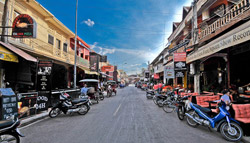 Siem Reap is an excellent place to buy Cambodian souvenirs, silks, handicrafts, textiles and contemporary art. Only Phnom Penh offers a comparable selection. In addition to the tradition shopping venues, over the last few of years there has been an explosion of new shops, galleries and boutiques, offering a varied selection of quality handicrafts and silks as well as original artistic creations in a variety of media.
Siem Reap is an excellent place to buy Cambodian souvenirs, silks, handicrafts, textiles and contemporary art. Only Phnom Penh offers a comparable selection. In addition to the tradition shopping venues, over the last few of years there has been an explosion of new shops, galleries and boutiques, offering a varied selection of quality handicrafts and silks as well as original artistic creations in a variety of media.
Phsar Chas (Old Market) is one of Siem Reap’s largest traditional covered markets and offers the largest selection of souvenirs under one roof in town. In fact, this market is really a ‘must visit’ in itself for the unique, colorful, local shopping experience. Of all the local markets, the Old Market offers the widest variety of souvenirs as well as the best selection of handicrafts and curios, including such items as traditional silverwork, silks, baskets, statuary, carvings and traditional musical instruments. Also check out the just opened Angkor Night Market off Sivatha. The new night market promises an interesting after hours shopping venue.
Individual little boutiques, art and photo galleries are scattered across the town, though there is a concentration of places in the Old Market area. The boutiques tend to offer higher quality, more unique and sophisticated selections of items than the Old Market - some focusing on Cambodian silks and tailoring, others on high quality handicrafts, NGO-based crafts, Asian-inspired photographic and artistic creations or specialty items such as local candles, spices and teas. Perhaps most interestingly, a new generation of Cambodian artists is making its mark and contemporary Cambodian art is coming to the fore after decades of silence.
What to Buy
Hand-woven Cambodian silks, stone and woodcarvings, statues and castings, contemporary Cambodian art, Cambodian handicrafts and traditional musical instruments, temple rubbings, silver betel containers, colored gems and basketry are among the most popular souvenirs. The most useful and one of the cheapest souvenirs that you can buy is a traditional checkered Cambodian scarf (krama). If you don’t mind looking like a tourist, wear it around your neck like the locals to keep the intense tropical sun off the back of your neck.
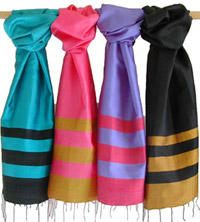 Cambodian Silks which are prized by silk collectors the world over. Most of the silk available in Cambodia is hand-loomed using the traditional ikat method of dying the threads and looming in the patterns. Both raw and fine silks are available in the form of bolts, sarongs, clothing and various handicrafts. Many of the pieces available are potential collector’s items. A fascinating way to learn about Cambodian silk is to visit the National Silk
Cambodian Silks which are prized by silk collectors the world over. Most of the silk available in Cambodia is hand-loomed using the traditional ikat method of dying the threads and looming in the patterns. Both raw and fine silks are available in the form of bolts, sarongs, clothing and various handicrafts. Many of the pieces available are potential collector’s items. A fascinating way to learn about Cambodian silk is to visit the National Silk
Center where visitors can witness start-to-finish silk creation - growing and harvesting mulberry (food for the silk worms), the breeding process and life cycle of the silk worm, collection of cocoons, separation and spinning the silk, the dying process and the creation of beautiful silk weavings on wooden, multi-harness hand looms. Cambodian silk is available at silk shops and boutiques across town, many specializing in silk creations such as tailored Asian and Euro-Asian fashions, pillows, blankets, purses and other decor and accessories. To learn more about Cambodian silk check the bookstore for ‘Traditional Textiles of Cambodia’ by Gillian Green
 Statues and carvings of traditional subjects, often copies of Angkorian era works as well as Buddhas and various Hindu gods and personages, are available in stone, wood and brass. Statues make for relatively heavy, bulky souvenirs but are still very popular because of their beauty and artistic value. The replica of an Angkorian era bust of Jayavarman VII with its graceful lines and peaceful smile is truly captivating and is perhaps the most popular piece. Statues and carvings are available at the Old Market and most souvenir shops, though it pays to shop around for the best price and quality. Highly-recommended is a stop at one of the local workshops such as Artisans D’Angkor to see craftsman producing wood and stone carvings. At Artisans d’Angkor visitors can observe artisans making traditional wood and stone carvings and lacquerwares following traditional techniques. Of special interest is the traditional polychromy finishing technique that is being practiced in the workshops. Polychromy imparts a unique patina to stone and wood pieces. Free tours available. See the Artisans d Angkor listing. Silver betel containers
Statues and carvings of traditional subjects, often copies of Angkorian era works as well as Buddhas and various Hindu gods and personages, are available in stone, wood and brass. Statues make for relatively heavy, bulky souvenirs but are still very popular because of their beauty and artistic value. The replica of an Angkorian era bust of Jayavarman VII with its graceful lines and peaceful smile is truly captivating and is perhaps the most popular piece. Statues and carvings are available at the Old Market and most souvenir shops, though it pays to shop around for the best price and quality. Highly-recommended is a stop at one of the local workshops such as Artisans D’Angkor to see craftsman producing wood and stone carvings. At Artisans d’Angkor visitors can observe artisans making traditional wood and stone carvings and lacquerwares following traditional techniques. Of special interest is the traditional polychromy finishing technique that is being practiced in the workshops. Polychromy imparts a unique patina to stone and wood pieces. Free tours available. See the Artisans d Angkor listing. Silver betel containers
Silver betel containers are popular, traditional souvenirs. These pounded silver containers are often shaped like animals, fruits and vegetables, and were originally used in ceremonial and everyday life to hold dried betel nut. (Betel is a type of palm nut that is chewed as a mild stimulant.) In the traditional market, betel looks like coin shaped, dark red plugs. You may see people, particularly older women from rural areas, with teeth stained deep red from years of chewing betel. Nowadays, silver betel containers are made primarily for sale as souvenirs but are still hand crafted using traditional techniques and styles. And in comparison to statues and carvings, they are comparatively light weight and transportable.
‘Temple rubbings’ are for sale everywhere in Siem Reap - the temples, the souvenir shops and the Old Market - but are, in fact, neither actual rubbings nor from the temples. They are in fact made from a heavy paper that is moistened then molded over recreations of original and imagined Angkorian-era temple carvings. Nevertheless, these rubbings are distinctive, light weight, transportable, inexpensive and uniquely Cambodian souvenirs.
Apsara Dance: Khmer Traditional Performances
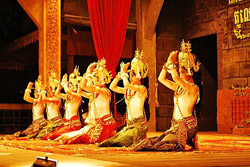 No visit to Cambodia is complete without attending at least one traditional Khmer dance performance, often referred to as 'Apsara Dance' after one of the most popular Classical dance pieces. Traditional Khmer dance is better described as 'dance-drama' in that the dances are not merely dance but are also meant to convey a story or message. There are four main modern genres of traditional Khmer dance: 1) Classical Dance, also known as Court or Palatine Dance (lakhon preah reach troap or lakhon luong); 2) Shadow theater (sbeik thom and sbeik toot); 3) Lakhon Khol (all-male masked dance-drama.); 4) Folk Dance (Ceremonial and Theatrical).
No visit to Cambodia is complete without attending at least one traditional Khmer dance performance, often referred to as 'Apsara Dance' after one of the most popular Classical dance pieces. Traditional Khmer dance is better described as 'dance-drama' in that the dances are not merely dance but are also meant to convey a story or message. There are four main modern genres of traditional Khmer dance: 1) Classical Dance, also known as Court or Palatine Dance (lakhon preah reach troap or lakhon luong); 2) Shadow theater (sbeik thom and sbeik toot); 3) Lakhon Khol (all-male masked dance-drama.); 4) Folk Dance (Ceremonial and Theatrical).
 As evidenced in part by the innumerable apsaras (celestial dancers) that adorn the walls of Angkorian and pre-Angkorian temples, dance has been part of Khmer culture for well more than a millennium, though there have been ruptures in the tradition over the centuries, making it impossible to precisely trace the source of the tradition. Much of traditional dance (especially Classical) is inspired by Angkorian-era art and themes, but the tradition has not been passed unbroken from the age of Angkor. Most traditional dances seen today were developed in the 18th through 20th centuries, beginning in earnest with a mid-19th century revival championed by King Ang Duong (reigned 1841-1869). Subsequent Kings and other Khmer Royals also strongly supported the arts and dance, most particularly Queen Sisowath Kossamak Nearireach (retired King Norodom Sihanouk's mother) in the mid-20th century, who not only fostered a resurgence in the study and development of Khmer traditional dance, but also helped move it out of the Palace and popularize it. Queen Sisowath Kossamak trained her grand daughter Princess Bopha Devi in the art of traditional dance from early childhood, who went on to become the face of Khmer traditional dance in the 1950s and 60s both in Cambodia and around the world. Many traditional dances that are seen in performances today were developed and refined between the 1940s and 1960s under the guidance and patronage of Queen Sisowath Kossamak at the Conservatory of Performing Arts and the Royal University of Fine Arts in Phnom Penh. Almost all of the Theatrical Folk dances that are presented in modern performances were developed during this period. Like so much of Cambodian art and culture, traditional dance was almost lost under the brutal repression of the Khmer Rouge regime of the late 1970s, only to be revived and reconstructed in the 1980s and 90s due, in large part, to the extraordinary efforts of Princess Bopha Devi.
As evidenced in part by the innumerable apsaras (celestial dancers) that adorn the walls of Angkorian and pre-Angkorian temples, dance has been part of Khmer culture for well more than a millennium, though there have been ruptures in the tradition over the centuries, making it impossible to precisely trace the source of the tradition. Much of traditional dance (especially Classical) is inspired by Angkorian-era art and themes, but the tradition has not been passed unbroken from the age of Angkor. Most traditional dances seen today were developed in the 18th through 20th centuries, beginning in earnest with a mid-19th century revival championed by King Ang Duong (reigned 1841-1869). Subsequent Kings and other Khmer Royals also strongly supported the arts and dance, most particularly Queen Sisowath Kossamak Nearireach (retired King Norodom Sihanouk's mother) in the mid-20th century, who not only fostered a resurgence in the study and development of Khmer traditional dance, but also helped move it out of the Palace and popularize it. Queen Sisowath Kossamak trained her grand daughter Princess Bopha Devi in the art of traditional dance from early childhood, who went on to become the face of Khmer traditional dance in the 1950s and 60s both in Cambodia and around the world. Many traditional dances that are seen in performances today were developed and refined between the 1940s and 1960s under the guidance and patronage of Queen Sisowath Kossamak at the Conservatory of Performing Arts and the Royal University of Fine Arts in Phnom Penh. Almost all of the Theatrical Folk dances that are presented in modern performances were developed during this period. Like so much of Cambodian art and culture, traditional dance was almost lost under the brutal repression of the Khmer Rouge regime of the late 1970s, only to be revived and reconstructed in the 1980s and 90s due, in large part, to the extraordinary efforts of Princess Bopha Devi.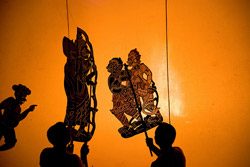 Shadow theatre comes in two forms: Sbeik Thom (big puppets that are actually panels depicting certain characters from the story) and Sbeik Toot (small articulated puppets). The black leather puppets are held in front of a light source, either in front or behind a screen, creating a shadow or silhouette effect. Sbeik Thom is the more uniquely Cambodian, more formal of the two types, restricting itself to stories from the Reamker. The performance is accompanied by a pin peat orchestra and narration, and the puppeteers are silent, moving the panels with dance-like movements. Sbeik Toot has a far lighter feel, presenting popular stories of heroes, adventures, love and battles, with or without orchestra and with the puppeteers often doing the narration.
Shadow theatre comes in two forms: Sbeik Thom (big puppets that are actually panels depicting certain characters from the story) and Sbeik Toot (small articulated puppets). The black leather puppets are held in front of a light source, either in front or behind a screen, creating a shadow or silhouette effect. Sbeik Thom is the more uniquely Cambodian, more formal of the two types, restricting itself to stories from the Reamker. The performance is accompanied by a pin peat orchestra and narration, and the puppeteers are silent, moving the panels with dance-like movements. Sbeik Toot has a far lighter feel, presenting popular stories of heroes, adventures, love and battles, with or without orchestra and with the puppeteers often doing the narration. Lakhon Khol is all male masked theatre presenting exclusively stories from the Reamker.
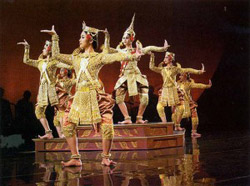 Most dance performances in Siem Reap offer a mixture of Classical and Theatrical Folk dances. A few venues offer Shadow Theater. Many of the dance performances in Siem Reap consist of 4-6 individual dances, often opening with an Apsara Dance, followed by two other Classical dances and two or three Theatrical Folk dances. The Apsara Dance is a Classical dance inspired by the apsara carvings and sculptures of Angkor and developed in the late 1940s by Queen Sisowath Kossamak. Her grand daughter and protégé, Princess Bopha Devi, was the first star of the Apsara Dance. The central character of the dance, the apsara Mera, leads her coterie of apsaras through a flower garden where they partake of the beauty of the garden. The movements of the dance are distinctly Classical yet, as the dance was developed for theatrical presentation, it is shorter and a bit more relaxed and flowing than most Classical dances, making it both an excellent example of the movements, manner and spirit of Classical dance and at the same time particularly accessible to a modern audience unaccustomed to the style and stories of Khmer dance-drama.
Most dance performances in Siem Reap offer a mixture of Classical and Theatrical Folk dances. A few venues offer Shadow Theater. Many of the dance performances in Siem Reap consist of 4-6 individual dances, often opening with an Apsara Dance, followed by two other Classical dances and two or three Theatrical Folk dances. The Apsara Dance is a Classical dance inspired by the apsara carvings and sculptures of Angkor and developed in the late 1940s by Queen Sisowath Kossamak. Her grand daughter and protégé, Princess Bopha Devi, was the first star of the Apsara Dance. The central character of the dance, the apsara Mera, leads her coterie of apsaras through a flower garden where they partake of the beauty of the garden. The movements of the dance are distinctly Classical yet, as the dance was developed for theatrical presentation, it is shorter and a bit more relaxed and flowing than most Classical dances, making it both an excellent example of the movements, manner and spirit of Classical dance and at the same time particularly accessible to a modern audience unaccustomed to the style and stories of Khmer dance-drama.
Another extremely popular dance included in most traditional dance performances in Siem Reap is the Theatrical Folk Dance known as the 'Fishing Dance.' The Fishing Dance is a playful, energetic folk dance with a strong, easy-to-follow story line. It was developed in the 1960s at the Royal University of Fine Arts in Phnom Penh and was inspired by the developer's interpretation of certain rather idealized and stereotyped aspects aspects of rural life and young love. Clad in rural attire, a group of young men and women fish with rattan baskets and scoops, dividing their attention between work and flirtatious glances. Women are portrayed as hardworking, shy, demurring and coy, whereas the young men are strong, unrestrained, roguish and assertive. As the dance continues a couple is separated from the group allowing the flirtations between them to intensify, only to be spoiled by the male character playing a bit too rough, leading to her coy rejection. He pokes and plays trying to win her back, bringing only further rejection. Eventually he gently apologizes on bended knee and after some effort, draws a smile and her attention once again. Just as they move together, the group returns, startling the couple and evoking embarrassment as they both rush to their 'proper' roles once again. The men and women exit at opposite sides of the stage, leaving the couple almost alone, but under pressure of the groups, they separate, leaving in opposite directions, yet with index finger placed to mouth, hint of a secret promise to meet again. (In an interesting side note, placing one's index finger to the lips to denote quiet or secrecy is not, generally speaking, a gesture found in Cambodia, but is common in the West. Its employment in the dance probably indicates a certain amount of 'foreign influence' amongst the Cambodian choreographers when the dance was developed in the 1960s.)
Tonle Sap Lake
 Cambodia's Great Lake, the Boeung Tonle Sap (Tonle Sap Lake,) is the most prominent feature on the map of Cambodia - a huge dumbbell-shaped body of water stretching across the northwest section of the country. In the wet season, the Tonle Sap Lake is one of the largest freshwater lakes in Asia, swelling to an expansive 12,000 km2. During the dry half of the year the Lake shrinks to as small as 2500 km2, draining into the Tonle Sap River, which meanders southeast, eventually merging with the Mekong River at the 'chaktomuk' confluence of rivers opposite Phnom Penh. But during the wet season a unique hydrologic phenomenon causes the river to reverse direction, filling the lake instead of draining it. The engine of this phenomenon is the Mekong River, which becomes bloated with snow melt and runoff from the monsoon rains in the wet season. The swollen Mekong backs up into the Tonle Sap River at the point where the rivers meet at the 'chaktomuk' confluence, forcing the waters of the Tonle Sap River back upriver into the lake. The inflow expands the surface area of lake more than five-fold, inundating the surrounding forested floodplain and supporting an extraordinarily rich and diverse eco-system. More than 100 varieties of waterbirds including several threatened and endangered species, over 200 species of fish, as well as crocodiles, turtles, macaques, otter and other wildlife inhabit the inundated mangrove forests. The Lake is also an important commercial resource, providing more than half of the fish consumed in Cambodia. In harmony with the specialized ecosystems, the human occupations at the edges of the lake is similarly distinctive - floating villages, towering stilted houses, huge fish traps, and an economy and way of life deeply intertwined with the lake, the fish, the wildlife and the cycles of rising and falling waters.
Cambodia's Great Lake, the Boeung Tonle Sap (Tonle Sap Lake,) is the most prominent feature on the map of Cambodia - a huge dumbbell-shaped body of water stretching across the northwest section of the country. In the wet season, the Tonle Sap Lake is one of the largest freshwater lakes in Asia, swelling to an expansive 12,000 km2. During the dry half of the year the Lake shrinks to as small as 2500 km2, draining into the Tonle Sap River, which meanders southeast, eventually merging with the Mekong River at the 'chaktomuk' confluence of rivers opposite Phnom Penh. But during the wet season a unique hydrologic phenomenon causes the river to reverse direction, filling the lake instead of draining it. The engine of this phenomenon is the Mekong River, which becomes bloated with snow melt and runoff from the monsoon rains in the wet season. The swollen Mekong backs up into the Tonle Sap River at the point where the rivers meet at the 'chaktomuk' confluence, forcing the waters of the Tonle Sap River back upriver into the lake. The inflow expands the surface area of lake more than five-fold, inundating the surrounding forested floodplain and supporting an extraordinarily rich and diverse eco-system. More than 100 varieties of waterbirds including several threatened and endangered species, over 200 species of fish, as well as crocodiles, turtles, macaques, otter and other wildlife inhabit the inundated mangrove forests. The Lake is also an important commercial resource, providing more than half of the fish consumed in Cambodia. In harmony with the specialized ecosystems, the human occupations at the edges of the lake is similarly distinctive - floating villages, towering stilted houses, huge fish traps, and an economy and way of life deeply intertwined with the lake, the fish, the wildlife and the cycles of rising and falling waters.
The lake sits only about 15 km south of Siem Reap town. If you take the ferry between Phnom Penh and Siem Reap you will cross the lake and dock at the village of Chong Khneas. There are several ways to see the culture and wildlife of the lake area depending on the amount of time you have and your interest.
Chong Khneas is the floating village at the edge of the lake closest and most accessible to Siem Reap. If you want a relatively quick and easy look at the Tonle Sap, boat tours of Chong Khneas are available, departing from the Chong Khneas boat docks all day long. From Siem Reap to the boat docks 11-15km and two-hour boat trip through the floating village to see the differing Khmer and Vietnamese floating households and the floating markets, clinics, schools and other boatloads of tourists.
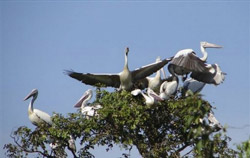 The 'bird sanctuary' at the Prek Toal core area of the Tonle Sap Biosphere Reserve has been called "the single most important breeding ground in Southeast Asia for globally threatened large waterbirds." The Biosphere covers 31,282 hectares at the northwest tip of the Tonle Sap Lake and plays host to species including Greater and Lesser Adjuncts, Black-headed Ibis, Painted Stork, Milky Stork, Spot-billed Pelican, Grey-Headed Fish Eagle and many more species. Of the three Biosphere core areas on the Tonle Sap Lake, Prek Toal is the most accessible from Siem Reap and the most popular with birdwatchers. The best time of year for viewing is the dry season when flocks of migratory birds congregate at Prek Toal. As the dry season progresses and the water recedes, the number of birds increases but the travel to some of the more important viewing areas becomes more difficult.
The 'bird sanctuary' at the Prek Toal core area of the Tonle Sap Biosphere Reserve has been called "the single most important breeding ground in Southeast Asia for globally threatened large waterbirds." The Biosphere covers 31,282 hectares at the northwest tip of the Tonle Sap Lake and plays host to species including Greater and Lesser Adjuncts, Black-headed Ibis, Painted Stork, Milky Stork, Spot-billed Pelican, Grey-Headed Fish Eagle and many more species. Of the three Biosphere core areas on the Tonle Sap Lake, Prek Toal is the most accessible from Siem Reap and the most popular with birdwatchers. The best time of year for viewing is the dry season when flocks of migratory birds congregate at Prek Toal. As the dry season progresses and the water recedes, the number of birds increases but the travel to some of the more important viewing areas becomes more difficult.
Kampong Phluk is a cluster of three villages of stilted houses built within the floodplain of the Tonle Sap about 16 km southeast of Siem Reap. The villages are primarily Khmer and have about 3000 inhabitants between them. Flooded mangrove forest surrounds the area and is home to a variety of wildlife including crab-eating macaques. During the dry season when the lake is low, the buildings in the villages seem to soar atop their 6-meter stilts exposed by the lack of water. At this time of year many of the villagers move out onto the lake and build temporary stilted houses. In the wet season when water level rises again, the villagers move back to their permanent houses on the floodplain, the stilts now hidden under the water. Kampong Phluk's economy is, as one might expect, based in fishing, primary in shrimp harvesting.
Kampong Phluk sees comparatively few foreign visitors and offers a close look at the submerged forest and lakeside village life as yet unperturbed by tourism. The area can be reached by boat from the Chong Khneas or by a combination of road and boat.
 Kampong Khleang is located on the northern lake-edge about 35 km east of Siem Reap town, more remote and less touristed than Kampong Phluk. Visitors to Kampong Khleang during the dry season are universally awestruck by the forest of stilted houses rising up to 10 meters in the air. In the wet season the waters rise to within one or two meters of the buildings. Like Kampong Phluk, Kampong Khleang is a permanent community within the floodplain of the Lake, with an economy based in fishing and surrounded by flooded forest. But Kampong Khleang is significantly larger with near 10 times the population of Kampong Phluk, making it the largest community on the Lake.
Kampong Khleang is located on the northern lake-edge about 35 km east of Siem Reap town, more remote and less touristed than Kampong Phluk. Visitors to Kampong Khleang during the dry season are universally awestruck by the forest of stilted houses rising up to 10 meters in the air. In the wet season the waters rise to within one or two meters of the buildings. Like Kampong Phluk, Kampong Khleang is a permanent community within the floodplain of the Lake, with an economy based in fishing and surrounded by flooded forest. But Kampong Khleang is significantly larger with near 10 times the population of Kampong Phluk, making it the largest community on the Lake.
The area can be reached by boat from the Chong Khneas docks or by a combination of road to Domdek on Route #6 and then boat to the village, the best method depending on the time of year. During the dry season, boats cannot get all of the way to the main villages.
Pagodas & Shrines
Buddhist pagodas are the traditional seat of Khmer culture. Siem Reap, like many Cambodian towns, is a collection of villages, which grew around individual pagodas, later coalescing into the town. To get a true feel for Cambodia, a visit to at least one pagoda is a must.
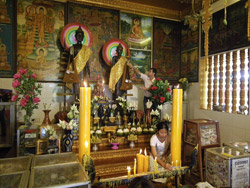 Shrine to Preah Ang Chek & Preah Ang Chorm Of particular importance to the locals is the small shrine in front of the Grand Hotel D’Angkor containing two standing Buddhas of the names Preah Ang Chek (taller) and Preah Ang Chorm (shorter). They are surrounded by stories of power and indestructibility. Visitors are welcome to make offerings and take photos. The reverence of local pilgrims is palpable.
Shrine to Preah Ang Chek & Preah Ang Chorm Of particular importance to the locals is the small shrine in front of the Grand Hotel D’Angkor containing two standing Buddhas of the names Preah Ang Chek (taller) and Preah Ang Chorm (shorter). They are surrounded by stories of power and indestructibility. Visitors are welcome to make offerings and take photos. The reverence of local pilgrims is palpable.
Shrine to Ya Tep Under a huge tree in the traffic circle in front of the royal residence is a statue of Ya Tep, a neak-ta. Neak-ta are powerful spirits connected to a particular area of land. Ya Tep is local to Siem Reap and is said to help bring protection (and winning lottery numbers) to the faithful. Offerings of chicken skins can often be seen around the shrine.
Wat Bo Founded in the 18th century. A large, highly respected pagoda. Like the Silver Pagoda in Phnom Penh, the vihear of Wat Bo contains very unique wall paintings of the Reamker that are said to be late 19th century. Look for the ordinary-life market scenes such as an opium smoking Chinese merchant, the colonial era French officer at the market and the French soldiers attending a traditional dance performance. Also of interest is the large collection of Buddha statues located behind the main Buddha.
Wat Keseram “Pagoda of the Cornflower Petals”. Pastoral setting and extensive, detailed collection of the life of Buddha on the interior of the vihear make this one of the more interesting wats to visit. The date of establishment is unclear, but most agree that the vihear was constructed in the early 1970’s.
Wat Preah Prohm Rath An unspectacular but idyllically situated wat on the river in the center of town. Founded in 1915, the main vihear was constructed in 1945. Oddly enough, the wat grounds hold two large cannons said to have belonged to the larger-than-life 20th century warlord, Dap Chhoun.
Wat Thmei (New Wat) The wat contains a unique glass-walled stupa containing the bones of victims of the Khmer Rouge. Some of the bones were recovered from a nearby well while others are the remains of soldiers who died on a nearby battlefield. 500m west of the road to Angkor about 1.5km north of town.
Countryside Tours
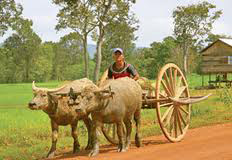 If your schedule allows, set aside a day or three to get out of the Siem Reap Town/main temple area and into the countryside. The vast majority of Cambodians live and work in the rural countryside and a countryside tour or even a day trip to a remote temple ruin can provide a glimpse of ‘real Cambodia’ - picturesque, bucolic scenery, rice paddies and water buffalos, countryside pagodas and little villages filled with traditional stilted houses... And there are a number of ways to see it: by SUV or dirtbikes, ATVs, bicycle, ox cart and more.
If your schedule allows, set aside a day or three to get out of the Siem Reap Town/main temple area and into the countryside. The vast majority of Cambodians live and work in the rural countryside and a countryside tour or even a day trip to a remote temple ruin can provide a glimpse of ‘real Cambodia’ - picturesque, bucolic scenery, rice paddies and water buffalos, countryside pagodas and little villages filled with traditional stilted houses... And there are a number of ways to see it: by SUV or dirtbikes, ATVs, bicycle, ox cart and more.
Beatocello and Jayavarman VII Children's Hospital
 Dr. Beat Richner plays Bach on the cello and speaks about the activities of his children’s hospitals (Jayavarman VII in Siem Reap, Kantha Bopha 1 and 2 in Phnom Penh) every Friday and Saturday evening at 7:15PM. Performances are held at the Jayavarman VII Hospital, located on the road to Angkor Wat in Siem Reap. Dr. Richner provides an entertaining and worthy Saturday evening. The hospital welcomes both monetary and blood donations.
Dr. Beat Richner plays Bach on the cello and speaks about the activities of his children’s hospitals (Jayavarman VII in Siem Reap, Kantha Bopha 1 and 2 in Phnom Penh) every Friday and Saturday evening at 7:15PM. Performances are held at the Jayavarman VII Hospital, located on the road to Angkor Wat in Siem Reap. Dr. Richner provides an entertaining and worthy Saturday evening. The hospital welcomes both monetary and blood donations.
Balloon Rides
Unique new addition to the Angkor area. Take a tethered helium balloon ride 200 meters straight up for an amazing aerial view of Angkor Wat, Phnom Bakheng, West Baray and other ruins amongst the surrounding jungle and rice paddies. Bring a camera and binoculars if you have them. The big, yellow balloon is based on the road from the airport to Angkor Wat, about a kilometer from the front gates of Angkor Wat.
Cambodian Cultural Village
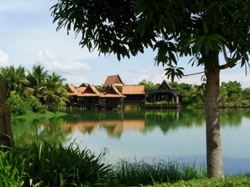 A unique, sprawling new cultural attraction in Siem Reap, intended to introduce the visitor to Cambodian culture and history. Wax museum with scenes and figures from history. Fascinating 1/20th scale models of sites such as Phsar Thmey and the Royal Palace in Phnom Penh and the hills and temples of Oudong. Full scale models of a variety of Cambodian architectural types, including different styles of huts and homes, hill tribe houses, pagoda and mosque. Live shows, traditional dance performances and music.
A unique, sprawling new cultural attraction in Siem Reap, intended to introduce the visitor to Cambodian culture and history. Wax museum with scenes and figures from history. Fascinating 1/20th scale models of sites such as Phsar Thmey and the Royal Palace in Phnom Penh and the hills and temples of Oudong. Full scale models of a variety of Cambodian architectural types, including different styles of huts and homes, hill tribe houses, pagoda and mosque. Live shows, traditional dance performances and music.
Elephant Rides
During the day, elephants await customers near Bayon or at the South Gate of Angkor Thom. In the evenings, elephants are stationed at the base of Phnom Bakheng, ready to transport riders up the hill for sunset.
Golf
Phokeethra Coutry Club Siem Reap’s first international golf club. 18-hole, 72 par golf course spread over 155 hectares and stretching 6.53 kms. A combination of paspulum grasses allows for year round golf. Putting green, pitching area, driving range, pro-shop and restaurant. Managed by Sofitel Royal Angkor Golf & Spa Resort. Located along Route #6 in Pouk district 16 kilometers from town.
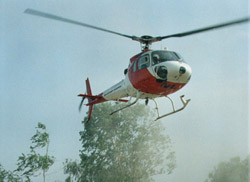 Helicopter Rides
Helicopter Rides
Helistar Helicopters offer scenic helicopter tours of the temples beginning at $50/pax. Specialized tours, aerial photography, charter services. Multiple aircraft. Conveniently located next to the big, yellow balloon about 1km from Angkor Wat on the road from the airport to Angkor Wat.
Angkor National Museum
The newly opened Angkor National Museum in Siem Reap promises eight chronologically ordered galleries of Angkorian-era artifacts and multi-media presentations of Angkorian history and culture. The Museum had just opened its doors and was not quite completed at time of printing, but should be very soon. Admissions price: US$12 (for foreigners). $2 for a camera. Hours: 9:00AM - 8:00PM. Located in town, on the road to the Angkor Park.
Mine Museum
Years of war have brought Cambodia one of the worst landmine problems in the world. The new Cambodia Land Mine Museum & Relief Facility contains an expanded exhibit displaying information and a variety of defused mines, bombs and other ordinance. The creator and proprietor of the museum, Akira, worked as a deminer in recent years. He is sometimes on hand to provide personal tours and tell of his experiences as a young soldier. Relevant and educational.
Massage and Spas
 After a long day of climbing around temple ruins, a relaxing foot massage or a reinvigorating afternoon at the spa can be just what the doctor ordered. Massage for health and relaxation is a time-honored tradition throughout Southeast Asia with Cambodia offering its own distinctive traditions in massage therapy. Siem Reap has several massage shops and spas catering to visitors. Massage shops are located across the town, especially in the Old Market area and along Sivutha Blvd. And don’t miss the latest smile inducing massage craze, fish massage, now available at several locations, especially around Pub Street. Immerse your feet in a pool of water and let hundreds of nibbling fish tickle away dead skin. Providing a more upscale experience and a broader range of services, boutique spas large and small, several located in the finer hotels, offer a generally pampered experience in an upscale, refined, pampered environment. The spas offer not only massage but full range of spa services including aromatherapy, body treatments, wraps, scrubs, beauty treatments, steams and sauna and spa packages.
After a long day of climbing around temple ruins, a relaxing foot massage or a reinvigorating afternoon at the spa can be just what the doctor ordered. Massage for health and relaxation is a time-honored tradition throughout Southeast Asia with Cambodia offering its own distinctive traditions in massage therapy. Siem Reap has several massage shops and spas catering to visitors. Massage shops are located across the town, especially in the Old Market area and along Sivutha Blvd. And don’t miss the latest smile inducing massage craze, fish massage, now available at several locations, especially around Pub Street. Immerse your feet in a pool of water and let hundreds of nibbling fish tickle away dead skin. Providing a more upscale experience and a broader range of services, boutique spas large and small, several located in the finer hotels, offer a generally pampered experience in an upscale, refined, pampered environment. The spas offer not only massage but full range of spa services including aromatherapy, body treatments, wraps, scrubs, beauty treatments, steams and sauna and spa packages.
Find and Book at our low price |










